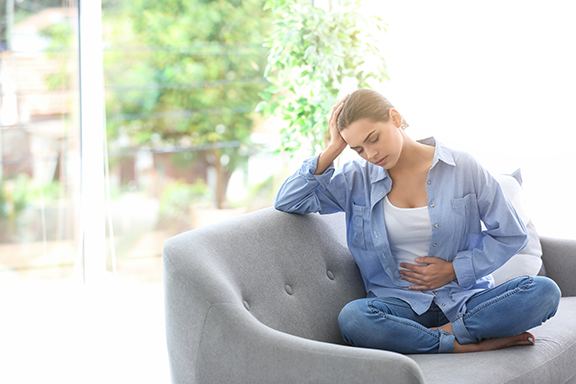One-third to one-half of women with endometriosis have difficulty getting pregnant. Many people may have heard of endometriosis, but they are unaware of how this condition can have an effect on fertility. The Mayo Clinic describes endometriosis as, “an often painful disorder in which tissue similar to the tissue that normally lines the inside of your uterus — the endometrium — grows outside your uterus. Endometriosis most commonly involves your ovaries, fallopian tubes and the tissue lining your pelvis” (1). There are women who develop endometrial tissue in other areas of the body, but this is typically considered rare. We are going to discuss this diagnosis, as well as natural and medicinal methods to treat it.
How is Endometriosis Diagnosed?
Endometriosis can be difficult to diagnose and most women who are affected by it could struggle to get a diagnosis for many years. Endometriosis has a vast range of symptoms that may mimic other diseases, which can complicate the diagnosis. Some of the main symptoms are:
- Painful periods
- Pain during sexual intercourse
- Infertility
Other symptoms can include:
- Pain outside of the period
- Digestive problems
- Pneumothorax
The cells can attach to major organs and every month during menstruation, those cells shed their lining just like the uterus. This is what causes endometriosis to be so painful.
Diagnosing endometriosis can be completed multiple ways such as: Pelvic exam, ultrasound, magnetic resonance imaging, and laparoscopy
Pelvic Exam
A doctor will insert one or two gloved fingers inside your vagina and while pressing down on your abdomen, they can evaluate your uterus, ovaries, and other pelvic organs. The doctor will be able to feel the difference between normal and abnormal tissue in your pelvis.
Ultrasound
During an ultrasound specifically performed to diagnose endometriosis, a doctor or sonographer will insert a small probe, called a transducer, into the vagina to capture images of the pelvis. They will examine your uterus, ovaries, and fallopian tubes to see if they have any anomaly. Cysts, a large uterus, adhesions with immobile organs can be clues to the presence of endometrial cells.
Magnetic Resonance Imaging
Magnetic resonance imaging, known more commonly as an MRI, can be performed to find endometrial cells deep inside the pelvis. An MRI can also be done to find endometrial cells in other parts of the body, although this is rarely ordered without specific symptoms.
Laparoscopy
The only sure way to diagnose endometriosis is through laparoscopic surgery. This type of surgery is low-risk but is usually still avoided if possible. The surgeon will make a small incision in the abdomen, near or in the belly button. A camera, called a laparoscope, will be inserted into the incision, which the surgeon will use to visualize internal organs looking for signs of endometriosis. If found, the anatomy can be restored and abnormal cells can be removed. This is an important diagnostic tool and can greatly help for relief of symptoms. However, it is temporary and the main treatment will always be medical for long term care and to avoid relapse.
Endometriosis and Fertility
There are many ways, both naturally and medically, to relieve symptoms of endometriosis and help fertility. Let’s first look at the different natural methods available for a woman considering natural childbearing.
Natural Methods
One of the methods to help relieve endometriosis symptoms is to focus on an anti-inflammatory diet that centers around eating foods high in antioxidants, such as fruits, vegetables, herbs, and spices. Studies have found that women who eat more Omega-3 fats experience relief in their symptoms. Some foods that could be incorporated into your diet are:
- Spinach, broccoli, beans, and beets
- Walnuts, dark chocolate
- Salmon
- Oranges, Berries
Nutrition is a key component of immune system health, so women with endometriosis could find relief from their symptoms after changing their diet.
Although we do not have evidence that hypnosis, psychotherapy or acupuncture help diminish symptoms or treat endometriosis, they are options that can be considered and explored.
Keep in mind that these natural methods will only treat symptoms and bring relief, not cure endometriosis.
Medical Treatments
Medical treatments are available to relieve and control endometriosis. These treatments can include pain medication, hormone therapy and surgery. Pain medication can bring relief from symptoms but is not a cure-all.
Hormones fluctuate during menstruation, which causes the endometrial cells to thicken and shed. Hormone therapy can be a more permanent pain reliever, sometimes eliminating the pain altogether. It is the main treatment plan for long term relief and prevention of worsening endometriosis. If you stop the treatment, symptoms could return unless you have reached the age of menopause, at which time endometriosis will be much less problematic. Different hormone treatments are available, including progestin therapy and birth control pills.
Another option to treat endometriosis is surgery. Surgeons can perform a laparoscopic procedure to remove endometrial cells while leaving your uterus and ovaries intact. The procedure is like the diagnosis laparoscopy, but the surgeon will actually remove or burn the endometrium tissue to relieve pain. If the surgery is successful, fertility may be improved although this remains controversial. Furthermore, a high number of women would have to get surgery in order to improve fertility for only one of them. Therefore, it is usually avoided when only considered for infertility.
The final option is IVF (in vitro fertilization) to stimulate the ovaries. According to contemporaryobgyn.net, “IVF clinical outcomes were evaluated based on rates of fertilization, implantation, and spontaneous pregnancy. The fertilization rate among patients with endometriosis was 70% compared to 67.1% for patients who did not have the condition” (2).
Natural and medical methods will mainly help relieve endometriosis pain, which is the first step before procreation.
When Treatments are No Longer Sufficient
If you have tried the natural and medical methods above and they are no longer working, that’s when you should contact a professional. Consult a doctor to establish a diagnosis and analysis of fertility beyond endometriosis. If tests are inconclusive, consult a fertility professional who may help identify more serious problems. You should also contact a professional if you experience multiple miscarriages.
Endometriosis Can Affect Fertility, But Each Case is Different
Even though endometriosis is painful, underdiagnosed, and can affect fertility, it does not mean you are infertile. Many women who are diagnosed with endometriosis have successfully conceived and given birth, both naturally and through IVF or other fertility treatments. It can take longer to conceive, but it is still a possibility.
If you have any of the symptoms listed at the beginning of the article or you are struggling with fertility, you should set up an appointment with your primary care doctor to get a diagnosis. The sooner you receive a diagnosis, the quicker your symptoms and pain can be resolved, and the sooner you can start to try to conceive.
Citations:
1. “Endometriosis”
2. “Study finds IVF success negatively correlates with endometriosis severity”










